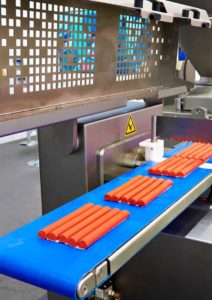Bacterial outbreaks leave the country suspicious of processed foods – how can stainless steel help allay these fears?
 According to the World Health Organisation, an estimated 600 million people fall ill after eating contaminated food every year, with 420 000 of these cases resulting in death. Of particular concern are food-borne illnesses caused by bacteria such as salmonella, campylobacter, e-coli and listeria. As such, providing sanitary conditions for the processing, handling, storage, transport and preparation of food and beverages is one of the most important objectives of the global food processing industry.
According to the World Health Organisation, an estimated 600 million people fall ill after eating contaminated food every year, with 420 000 of these cases resulting in death. Of particular concern are food-borne illnesses caused by bacteria such as salmonella, campylobacter, e-coli and listeria. As such, providing sanitary conditions for the processing, handling, storage, transport and preparation of food and beverages is one of the most important objectives of the global food processing industry.
The recent outbreak of listeriosis has made South Africans acutely aware of hygiene practices in the preparation of food, in particular with regards to meat and ready to eat (RTE) foods.
To safeguard the public from food-borne illnesses, regulatory bodies around the globe impose hygiene regulations on food processing and packaging equipment. Stainless steel enables these facilities to meet industry regulations while reducing the outbreak of many potentially fatal food-borne illnesses.
Bacteria is unavoidable, however, control, maintenance and effective cleaning can ensure hygiene standards are upheld.
Listeria monocytogenes occur naturally in the environment and are normally present. Ready to eat foods, such as cold meats, are often the source of listeria infections, such as in the recent outbreak in South Africa. This is because their long shelf life is conducive to bacterial growth and these foods are usually consumed without any additional cooking.
According to the European Food Safety Authority, the bacterial food safety limit should be kept to a maximum level of 100 colony-forming unit per gram (cfu/g). With RTE foods, refrigeration temperatures should be kept below 4oC and frozen foods below -18oC.
In addition, hygiene control is critical. There are no standard limits in South Africa, but processors normally voluntarily abide by international standards. Dairymaid, for example, ensure that listeria monocytogenes remain below 10 cfu/g.
KEEPING THINGS CLEAN
 Stainless steel is the most common type of material used in the food processing industry. “Food processing plants make extensive use of stainless steel, especially during product – equipment contact to maintain and exceed minimum hygiene requirements,” says Michel Basson, the Cape regional manager of Sassda.
Stainless steel is the most common type of material used in the food processing industry. “Food processing plants make extensive use of stainless steel, especially during product – equipment contact to maintain and exceed minimum hygiene requirements,” says Michel Basson, the Cape regional manager of Sassda.
Logan Moodley of NDE agrees, adding that “the spike in listeria bacteria was the result of the manufacturing of processed food in an unhygienic environment, where the bacteria was found to be present outside of the food processing equipment and resulted in the entire plant being contaminated”.
Cleanability is key in food processing and the fact that stainless steel retains its original surface profile throughout the life ensures a smooth surface and effective cleaning with no place for the bacteria to hide. The lack of deterioration of the surface (through either corrosion or mechanically roughening of the surface as would be the case in softer materials) ensures that this smooth sterile surface can be maintained throughout the life of the food processing equipment.
“The quality of the surface finish of stainless steel is one of the most important factors in determining the quality of the end product in a food processing factory because it contributes to decreasing the bacteria count in food products,” says Moodley.
GRADE SELECTION
Not all stainless steels are made alike, and those used in the manufacturing of food products need to be of a high enough standard to contribute sufficiently in the manufacturing of these foodstuffs. So, when kitting out a manufacturing plant it’s key to know what stainless steel to use.
“The quality of the surface finish is one the most important factors in determining the quality of the end product in a food processing factory because it contributes to decreasing the bacteria count in food products. Stainless steel is available in many surface finishes. It is ideal to use a surface finish of 2B or better,” explains Moodley.
“It’s preferable to use an austenitic stainless steel with a minimum of 18% chromium and 10% nickel composition, which is commonly known as grade 304, in a 2B or mirror finish. The stainless steel should be manufactured to DIN 11850 / 1 – the standard used in the food industry.”
Basson agrees, adding that it’s important to remember that “the lowest price does not mean the best product. Always do a proper investigation on process requirements and then base cost on an appropriate grade selection and process solution. This can then be compared to competitive costing over the product life span.
“Use a tool such as the Sassda Life Cycle Costing application for both Apple and Android to do this. A PC version is available from our website at the following link LCC Software ”
CONSISTENT STANDARDS
 As long as each manufacturer is left to their own devices to select the grades of steel to be used in their plants, there will be room for sub-standard hygiene factors to bloom. As a way to counter this, legislation needs to be put in place that guides those in the food processing industry as to the minimum steel requirements to be used in these plants.
As long as each manufacturer is left to their own devices to select the grades of steel to be used in their plants, there will be room for sub-standard hygiene factors to bloom. As a way to counter this, legislation needs to be put in place that guides those in the food processing industry as to the minimum steel requirements to be used in these plants.
“This will provide guidance to manufactures. Adherence to these standards will ensure consumers will receive safe and trustworthy products,” adds Moodley.
Surfaces and equipment that come in contact with food products must not only be easy to clean and sanitise, but also have surfaces that naturally inhibit food adhesion and bacterial growth.
Having no pores or cracks to harbour dirt, grime or bacteria, stainless steel is easily sterilised with harsh products such hydrogen peroxide.
When it comes to food preparation, stainless steel is suitable for environments where scratches might occur, and is highly durable and long-lasting, which helps to save costs. Unlike other materials, stainless steel is also generally inert to most of the acids and alkalis released by cooked foods, spices and additives. The metal does not normally get pitted, a form of corrosion that leads to the creation of small holes in the metal, thus avoiding the worst chance for bacterial infection.
Stainless steel has proved itself worthy in areas where sanitation and cleanability are imperative. The material’s hygienic properties, corrosion resistance, strength and formability benefit both fabricators and users in the food and beverage industry, making it the go-to material in restaurants and public kitchens around the world.


